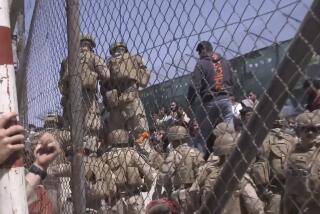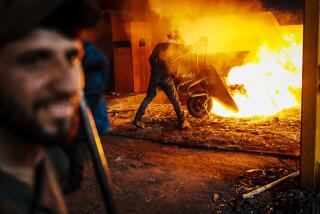Suicide Attacks on NATO Escalating in Afghanistan
- Share via
KANDAHAR, Afghanistan — As NATO troops replace U.S. forces on southern Afghanistan’s battlefields, insurgents are waging a suicide bombing campaign that appears aimed at shaking the alliance’s public support in Europe and Canada.
Four years after the Taliban regime was toppled, the test of wills threatens to set back the U.S.-led war on terrorism in Afghanistan, American and Afghan analysts say.
Suicide bombings were rare in Afghanistan until last fall, when the North Atlantic Treaty Organization began debating a move into southern Afghanistan.
The mission is expected to draw NATO into the first ground combat in its 57-year history. Fighting Taliban and Al Qaeda militants in rugged, often mountainous terrain would be a major step beyond NATO’s previous peacekeeping missions or the alliance’s 78-day air war against Serbia in 1999 to end atrocities in Kosovo. The NATO forces are set to take over from U.S. troops in southern Afghanistan this spring, but will depend on American attack helicopters and other aircraft for support.
The decision to take on the mission came only after considerable debate within the alliance. The formal discussion began in September, about the time insurgents launched a wave of suicide attacks. At least 22 suicide bombers have struck since then, more than double the total for the previous three years.
Bombers have targeted Canadian, German, Italian, Portuguese and other NATO troops, whose main mission has been peacekeeping and building schools and hospitals, not fighting insurgents..
Mir Akbar Ansari, a senior prosecutor in Afghanistan’s anti-terrorism courts, believes that the suicide bombers are going after NATO troops because they see them as weak links in the efforts to stabilize Afghanistan.
“I think the rise of attacks in Afghanistan nowadays is aimed at the weak forces, such as Canada and others, and that is because these countries can easily be threatened,” Ansari said.
“The terrorists want the Americans to be alone in Afghanistan, so that they can deal with them later. Al Qaeda doesn’t want to leave its nest in Afghanistan.”
Afghan officials say the bombers are overwhelmingly foreigners, mainly Arabs and Pakistanis who usually enter the country from Pakistan.
Officials in Islamabad, the Pakistani capital, insist they are doing everything they can to prevent that. But in talks this week, Afghan President Hamid Karzai pressed Pakistani President Pervez Musharraf for a “more intensive pursuit of terrorists, wherever they may be.”
“We have to fight them jointly and we have to trust each other that we are fighting them jointly,” Musharraf told reporters in Islamabad after the meeting with Karzai.
The escalating violence against NATO forces has strained relations between the two neighbors, both close U.S. allies. Roughly two-thirds of the suicide attacks against NATO soldiers, who arrived here in 2003, have occurred in the last six months as member governments have tried to rally support for the dangerous mission, said Philip Gordon, a senior fellow at the Brookings Institution in Washington.
“It is impossible to get into the heads of the insurgents, but it sure looks like they’ve developed a conscious strategy of deterring those countries that are in the NATO mission,” Gordon said. He was part of a team of experts who assessed the alliance’s operations on a NATO-sponsored trip to Afghanistan in December.
That strategy threatens to undermine the counterinsurgency effort because some NATO governments are reluctant to get into a war with the rebels, Gordon said.
“There is a risk that NATO troops being deployed won’t be as willing to fight as the U.S. troops that were there,” he said. “They go out of their way to avoid any kind of clashes, and that’s not the mission in the south. It’s going after terrorists.”
Italian Lt. Col. Riccardo Cristoni, NATO’s chief spokesman in Afghanistan, said the alliance had no evidence that insurgents were targeting non-U.S. troops as part of a new strategy, but said it could not rule out any possibility.
“We know that these kinds of terrorist organizations are very keen on putting pressure on the [home] audience. We have seen this in the Iraq situation and during the Spanish election” in 2004, when Al Qaeda-linked bombers struck Madrid trains, killing 191 people, Cristoni said.
Since the Taliban ouster in late 2001, U.S. and Afghan forces have led the counter-terrorism campaign and lost the most troops in combat.
But the Bush administration wants to cut the number of U.S. troops in Afghanistan from about 19,000 to 16,500 by spring. Over the coming weeks, NATO will add about 7,000 troops, bringing it to roughly the same size as the U.S. contingent.
Canadian, British, Dutch and Danish soldiers are setting up bases in Kandahar, Helmand and Oruzgan provinces, where insurgents and drug lords are expected to put up fierce resistance.
Some of the worst suicide attacks have come in Kandahar, once the base of fugitive Taliban leader Mullah Mohammed Omar.
One bomber rammed a car packed with explosives into a Canadian military convoy here, killing a senior Canadian diplomat and two passersby. Two Canadian soldiers suffered severe head wounds.
Late last month, Afghan security forces said they arrested at least six Pakistanis and Arabs in Kandahar. Karzai said they were part of “a big ring of terrorists” that reached across the country to Herat in the west. One of the men was captured after his explosives failed to detonate, Kandahar Gov. Asadullah Khalid said.
As investigators try to track the suspects’ alleged foreign links, the prisoners are locked in a row of small rooms in an Afghan intelligence agency building in Kandahar. They sit one to a room, with shackles around their necks, wrists and ankles that are joined by chains that restrict their movements.
“Some of them said, ‘We are sorry for what we did, we made a big mistake,’ ” said Khalid, who has interrogated the prisoners.
Karzai and other Afghan officials have suggested that some suicide bombers are dupes, Afghan drug addicts or others tricked into carrying out attacks. But several would-be bombers arrested here in recent weeks came from Iraq, Chechnya and Pakistan, where Al Qaeda is known to recruit terrorists, Afghan authorities said.
Afghanistan’s anti-terrorism courts have prosecuted more than 24 people accused of plotting suicide attacks and only a few were Afghans, said Ansari, the anti-terrorism prosecutor.
One alleged bomber is Rana Abad, who was arrested Dec. 16 in Kabul on suspicion that he was casing a police station for an attack. He had a photo identity card issued by Pakistan’s government. But he entered the country without a passport or an Afghan visa, according to his court file.
In his statement to interrogators, signed on each page with a blue fingerprint, Abad confessed that he had come to Kabul to carry out a suicide attack.
Apart from his ID card, Abad had almost $300 in Afghan and Pakistani currency in his wallet and a used bus ticket from the Pakistani city of Lahore to Rawalpindi, near Islamabad, about 250 miles east of Kabul. It was dated Dec. 14, two days before his arrest.
Abad, who awaits trial, told interrogators that he had dropped out of medical school and then engineering school and traveled more than seven months as a preacher with the Tablighi Jamaat, a Muslim missionary group dominated by the ultraconservative Wahhabi sect.
The missionary group is suspected of recruiting militants for Al Qaeda and allied groups in Pakistan and other countries.
Abad said he was recruited by an unnamed militant group and received 20 days of training in the use of various weapons before coming to Kabul.
More to Read
Sign up for Essential California
The most important California stories and recommendations in your inbox every morning.
You may occasionally receive promotional content from the Los Angeles Times.













